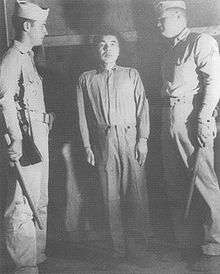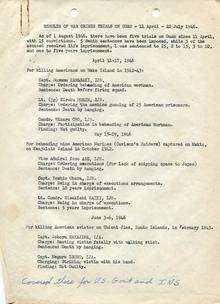Kōsō Abe
| Kōsō Abe | |
|---|---|
 Admiral Kōsō Abe (center) during the Guam War Crimes trial, 1946 | |
| Born |
March 24, 1892 Mikawa, Yamagata, Japan |
| Died |
June 19, 1947 (aged 55)[1] Guam |
| Allegiance |
|
| Service/branch |
|
| Years of service | 1912-1945 |
| Rank | Vice Admiral |
| Commands held |
Jintsu, Naka, Tenryū, Mikuma, Myōkō, Hiei 6th Air Base Group Tateyama Naval Gunnery School |
| Battles/wars |
World War II oBattle of the Coral Sea oMakin Raid |
Kōsō Abe (阿部 孝壮 Abe Kōsō, 24 March 1892 – 19 June 1947) was an admiral in the Imperial Japanese Navy during World War II.
Biography
Early career
A native of what is now the town of Mikawa, Yamagata prefecture in northern Japan, Abe was a graduate of the 40th class of the Imperial Japanese Naval Academy in 1912. He ranked 73rd out of 144 cadets. He served as midshipman on the cruisers Azuma and Yakumo from 1912–1913, and after commissioning as an ensign in 1915, was assigned to the cruiser Izumo. He returned to naval artillery and torpedo school later that year, and did not graduate until late 1917, so he was unable to participate in combat operations in World War I.
As a lieutenant from 1918, lieutenant commander from 1924, and commander from 1930, he served as chief gunnery officer on the destroyers Yamakaze and Akikaze, cruisers Asama, Naka and Ashigara, and battleships Haruna, Yamashiro and Hyūga. He was promoted to captain on 15 November 1934.
Abe was given his first command on 15 November 1935, the cruiser Jintsu. He subsequently served as captain of Naka, Tenryū, Mikuma, Myōkō, and Hiei in the 1930s.
Abe was promoted to rear admiral on 15 November 1940. He commanded the transport division for the Port Moresby Invasion Force in abortive Operation Mo during the Battle of the Coral Sea.
The Makin Raid incident
From 5 February 1942 – 29 November 1943, Abe was commander of the 6th Base Force at Kwajalein in the Marshall Islands. As such, he was essentially the wartime military governor of the Marshall Islands, Gilbert Islands, Nauru, Ocean Island and Wake Island in the central Pacific Ocean.
On 17–18 August 1942, a force of approximately 200 US Marine commandos landed by submarine and raided Makin Island. The Makin Island raid was intended to destroy Japanese installations, gather intelligence data, test raiding tactics, boost home front morale, and possibly to divert Japanese attention from Guadalcanal. At a loss of 30 men, the US Marines killed the 85 - 160 Japanese, destroyed the radio station, fuel depot, supplies and installations. The raid attracted much attention in the American press, spawning a 1942 propaganda movie entitled Gung Ho!, but its military significance was negligible. Nine US Marines who had been accidentally left behind during the raid were captured by Japanese forces, and moved as prisoners of war to Kwajalein, where they were held for about a month.
The initial plan was to send those American prisoners to Japan for incarceration. However, reportedly over the protests of Captain Yoshio Obara (local Japanese commander on Kwajalein) and Commander Hiusakichi Naiki (Chief of military-police on Kwajalein) (although this has been disputed by historian W. Emerson Wiles who states that Obara and Naiki were willing participants), Abe ordered the execution of the prisoners by beheading on 16 October 1942.[2]


Subsequent career
From 27 December 1943 – 25 April 1945, Abe was Commandant of the Tateyama Naval Gunnery School in Tateyama, Chiba, Japan. Until the end of the war, he served as a commander of base units at Sasebo Naval Base in Kyūshū, Japan.[1]
After the war, Abe was arrested by SCAP authorities and charged with war crimes, largely based on witness testimony regarding the Makin Raid Incident. Abe was extradited to Guam, where a military tribunal convicted him of "violation of the law and custom of war and the moral standards of civilized society." Abe was executed by hanging on 19 June 1947 on Guam.[3]
References
Printed sources
- Fuller, Richard (1992). Shokan: Hirohito's Samurai. London: Arms and Armour Press. ISBN 978-1-85409-151-2.
- Morison, Samuel Eliot (2001) [1949]. Coral Sea, Midway and Submarine Actions, May 1942-August 1942, vol. 4 of History of United States Naval Operations in World War II. Champaign, Illinois, USA: University of Illinois Press. ISBN 978-0-252-06995-6.
- Morison, Samuel Eliot (1961). Aleutians, Gilberts and Marshalls, June 1942-April 1944, vol. 7 of History of United States Naval Operations in World War II. Boston: Little, Brown and Company. ASIN B0007FBB8I.
- Smith, George W. (2003). Carlson's Raid: The Daring Marine Assault on Makin. Berkley Trade. ISBN 978-0-425-19019-7. - Neutral review of this book:
- Wiles, W. Emerson "Tripp" (2007). Forgotten Raiders of '42: The Fate of the Marines Left Behind on Makin. Potomac Books. ISBN 978-1-59797-055-6.
- Young, Howard. "Carlson's Raiders on Makin, 17–18 August 1942", Marine Corps Gazette 87(8): August 31, 2003.
External links
- Crowl, Philip A.; Edmund G. Love (1955). "Seizure of the Gilberts and Marshalls". United States Army in World War II - The War in the Pacific. Office of the Chief of Military History, Department of the Army. pp. 60–66. Retrieved January 23, 2007. - Briefly describes the Makin Raid and its impact on future U.S. operations in the Gilbert Islands.
- Hoffman, Jon T. (1995). "Makin" (brochure). FROM MAKIN TO BOUGAINVILLE: Marine Raiders in the Pacific War. Marine Corps Historical Center. Retrieved 2006-11-21.
- Nishida, Hiroshi. "Imperial Japanese Navy: Abe, Koso". Retrieved 2008-08-25.
- Whitman, Edward C. "SUBMARINE COMMANDOS: "Carlson's Raiders" at Makin Atoll". Undersea Warfare. United States Navy, Chief of Naval Operations, Submarine Warfare Division. Retrieved 2006-11-21.
